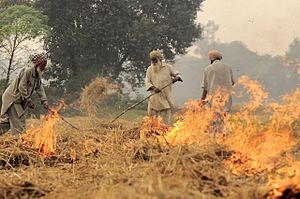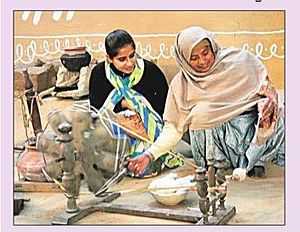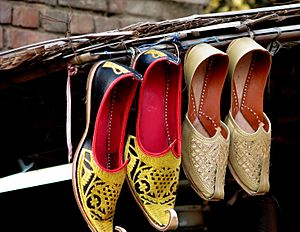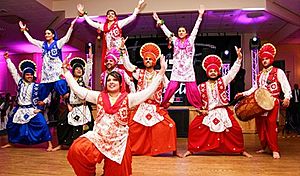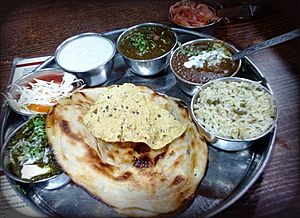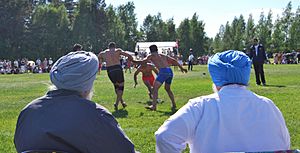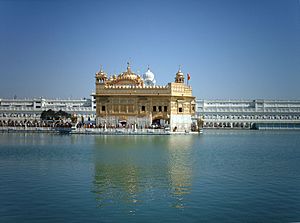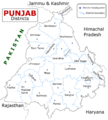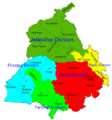Punjab (India) facts for kids
Quick facts for kids
Punjab
ਪੰਜਾਬ
|
||
|---|---|---|
|
State of India
|
||
|
||
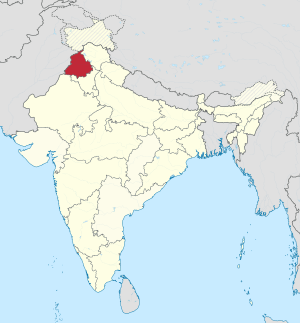
A map showing us where the location of Punjab is in the Republic of India
|
||
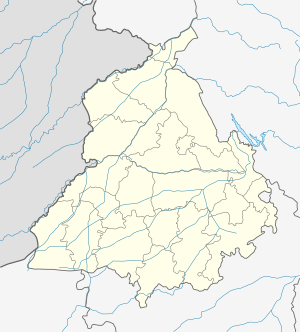
Map of Punjab
|
||
| Country | ||
| Region | North India | |
| Established | 1 November 1966 | |
| Area | ||
| • Total | 50,362 km2 (19,445 sq mi) | |
| Population
(2011)
|
||
| • Total | 27,704,236 | |
| Time zone | UTC+05:30 (IST) | |
| Official languages | Punjabi · English | |
| 294 elected, 1 nominated | ||
Punjab is a state in northern India. It is often called the "Land of Five Rivers." About 27 million people live here. Its capital city is Chandigarh. Chandigarh is a special territory. It is also the capital of the nearby state of Haryana.
Punjab is part of the larger Punjab region. It covers an area of 50,362 km² (19,445 mi²). This makes it bigger than Slovakia but smaller than Costa Rica. Punjab has 22 districts.
Some of Punjab's major cities include Ludhiana, Amritsar, Patiala, Jalandhar, and Chandigarh.
Punjab has a long history. It grew from settlements along its five rivers. These rivers were important trade routes in ancient times. Agriculture has always been a key part of Punjab's economy and culture. People's social status was often linked to how much land they owned.
Over centuries, Punjab faced many invasions. This was because it was on a main route into India. Groups like the Persians, Greeks, Turks, and Mongols invaded the region. This history led to a culture where protecting the land was very important. Later, the Marathas, Durranis, and British also came to the region.
The word "Punjab" has changed its meaning over time. In the 16th century, it meant a smaller area between the Indus and Sutlej rivers. Before 1947, the British Punjab Province was much larger. It included parts of present-day India and Pakistan. Today, the Indian state of Punjab is one part of that historical region.
Most people in Punjab speak the Punjabi language. In the Indian state of Punjab, most people are Punjabi Sikhs or Punjabi Hindus. Other religions like Christianity, Jainism, and Buddhism are also present.
Contents
What Does Punjab Mean?
The name Punjab means "The Land of Five Waters." It refers to five important rivers: Jhelum, Chenab, Ravi, Sutlej, and Beas. Ancient Indian texts also mention a "land of five rivers."
A Brief History of Punjab
India was once ruled by the British Empire. When India gained freedom, the country was divided in 1947. This was because of disagreements between Hindus, Sikhs, and Muslims. The old province of Punjab was split into two parts. West Punjab became part of Pakistan. East Punjab became part of modern India.
Symbols of East Punjab
Geography of Punjab
Punjab is located in northwestern India. It covers about 50,362 square kilometers. To its west is Pakistan. To the north is Jammu and Kashmir. Himachal Pradesh is to the northeast. Haryana and Rajasthan are to the south.
Most of Punjab is a flat, fertile plain. It has many rivers and a large system of irrigation canals. There are some rolling hills in the northeastern part. These are at the foot of the Himalayas. The land is generally about 300 meters (984 feet) above sea level. It ranges from 180 meters (590 feet) in the southwest to over 500 meters (1,640 feet) in the northeast. The southwest part of the state is quite dry. It eventually turns into the Thar Desert.
The soil in Punjab varies. It is divided into three main types: southwestern, central, and eastern. Punjab is also in different earthquake zones. This means some areas have a low risk of damage, while others have a moderate or high risk.
Punjab's Climate
Punjab has big temperature changes throughout the year. This is because of its location. Even though it rarely gets below freezing, ground frost is common in winter. Temperatures rise slowly with high humidity. But they rise quickly when the sky is clear and humidity is low.
The hottest temperatures are usually in May and June. During this time, temperatures often stay above 40°C (104°F). Ludhiana once recorded a high of 46.1°C (115°F).
The coldest temperatures are from December to February. January is the coldest month. Amritsar once recorded 0.2°C (32.4°F). Temperatures often stay below 5°C (41°F) for about two months in winter. The average yearly temperature in Punjab is around 21°C (70°F).
Seasons in Punjab
Punjab experiences three main seasons:
- Hot Season: From mid-April to the end of June.
- Rainy Season: From early July to the end of September.
- Cold Season: From early December to the end of February.
There are also two short seasons that connect these main ones:
- Pre-summer Season: March to mid-April. This is when winter changes to summer.
- Post-monsoon Season: September to end of November. This is when the rainy season changes to winter.
Summer in Punjab
Punjab starts getting warm in February. But the real summer begins in mid-April. During summer, the air pressure changes. It drops from about 987 millibars in February to 970 millibars in June.
Rainy Season in Punjab
The monsoon season brings much happiness to farmers. They become very busy planting crops. Punjab's rainy season starts in the first week of July. Monsoon winds from the Bay of Bengal bring rain to the region.
Winter in Punjab
Temperatures don't change much in January. The average night temperature is about 5°C (41°F). The average day temperature is about 12°C (54°F).
Post-Monsoon Season
The monsoon rains start to lessen by the second week of September. The weather slowly changes. October and November are the transition months between the monsoon and winter. The weather during this time is usually clear and dry.
Post-Winter Season
Winter ends by the first week of March. The hot summer season begins in mid-April. This period can have occasional showers. Sometimes, there are hail storms and strong winds called squalls. These can damage crops. By the last week of March, the winds become dry and warm. This marks the start of the harvest season.
Rainfall in Punjab
- Monsoon Rainfall: Most of Punjab's rain comes during the monsoon season. The monsoon winds from the Bay of Bengal enter the state from the southeast in early July.
- Winter Rainfall: Winters are very cool, with temperatures sometimes falling below freezing. Western disturbances also bring some rain in winter. This winter rain helps farmers. Some winter crops in the Shivalik Hills depend entirely on this rainfall. Areas near the Shivalik Hills get over 100 mm (4 inches) of rain in winter.
Animals and Plants of Punjab
Punjab has many types of animals and birds. There are 396 kinds of birds, 214 types of butterflies and moths, 55 kinds of fish, 20 types of reptiles, and 19 kinds of mammals.
The state has large wetland areas and bird sanctuaries. These places are home to many bird species. Some famous wetlands include Hari-Ke-Pattan and Kanjli. Wildlife sanctuaries like Harike in Tarn Taran Sahib and zoological parks in Rupnagar are also important.
Wildlife in Punjab
Some rivers in Punjab have crocodiles. Making silk from silkworms is also an industry here. Bee honey production happens in some parts of Punjab. In the southern plains, which are desert-like, you can see camels. Buffaloes graze near rivers. The northeastern part has animals like horses.
Wildlife sanctuaries protect many wild animals. These include otters, wild boars, wildcats, fruit bats, hog deer, flying foxes, squirrels, and mongooses. Natural forests are found in the Shivalik ranges. These are in the Ropar, Gurdaspur, and Hoshiarpur districts. Patiala has the Bir forest. The wetlands have the famous Mand forest.
Punjab also has botanical gardens, a zoological park, and a tiger safari park. There are also three parks just for deer.
The state bird of Punjab is the baz (northern goshawk). The state animal is the blackbuck. The state tree is the shisham (Dalbergia sissoo).
Punjab's Economy
Punjab is one of the most fertile regions in India. It is excellent for growing wheat. Rice, sugarcane, fruits, and vegetables are also grown. Indian Punjab is often called the "Granary of India" or "India's bread-basket." It produces a large amount of India's cotton, wheat, and rice. The Firozpur and Fazilka Districts are the biggest producers of wheat and rice in the state.
The most grown crop is wheat. Other important crops include rice, cotton, sugarcane, pearl millet, maize, and barley. Farmers often grow rice and wheat one after the other. After harvesting rice, the stalks are sometimes burned. This prepares the land quickly for wheat planting. However, this practice causes pollution and wastes resources.
Farmers in Punjab use a lot of fertilizer. This is much more than the national average in India. Punjab has won awards for its agriculture services. But in recent years, crop production has slowed down. This is thought to be because of too much fertilizer and pesticides. Another big concern is the rapidly falling water table. Almost 90% of farming depends on groundwater. The water level is dropping by a meter or more each year.
Punjab has one of the lowest levels of hunger in India.
Culture of Punjab
Punjabi culture is rich and diverse. It includes lively music like bhangra. There are many religious and non-religious dance traditions. Punjabi literature has a long history of poetry. The Punjabi film industry is also important.
Punjabi food is very popular around the world. People celebrate many seasonal and harvest festivals. These include Lohri, Basant, Vaisakhi, and Teeyan. These are celebrated along with other religious festivals in India.
A kissa is a traditional Punjabi story. These stories are told orally and have roots from different parts of Asia.
Punjabi wedding traditions are a big part of Punjabi culture. Weddings are known for their many rituals, songs, dances, food, and special clothes. These traditions have developed over many centuries.
Bhangra Dance
Bhangra and Giddha are popular dance and music styles. They started in the Punjab region.
Bhangra began as a folk dance. Punjabi farmers would dance it to celebrate the harvest season. The dance moves show how villagers used to farm their land. This dance has become very popular in Western countries. Punjabi people in England, Canada, and the USA hold competitions. It is seen as a symbol of South Asian culture. Today, Bhangra is found in pop music, movies, and cultural shows worldwide.
Punjabi Folk Tales
The folk heritage of Punjab shows its thousands of years of history. While Majhi is the main dialect of Punjabi language, there are other Punjabi dialects. These include Malwai, Doabi, and Puadhi. Songs, stories, and poems are often written and sung in these dialects.
Many folk tales are popular in Punjab. These include stories like Mirza Sahiban, Heer Ranjha, Sohni Mahiwal, and Sassi Punnun. Mystic folk songs and religious songs include the Shalooks of Sikh gurus and Baba Farid.
The most famous romantic love songs are Mayhiah, Dhola, and Boliyan. Punjabi romantic dances include Dhamaal, Bhangra, Giddha, Dhola, and Sammi.
Punjabi Literature
Most early Punjabi writings were in poetry form. Prose became more common later. Throughout its history, Punjabi literature has aimed to teach, inspire, and entertain. The Punjabi language is written in different scripts. The Shahmukhi and Gurmukhī scripts are the most used.
Punjabi Music
Punjabi Folk Music uses traditional musical instruments from the Punjab region.
Bhangra music from Punjab is famous all over the world.
Punjabi music has many styles. These range from folk and Sufi music to classical music. Famous classical styles include the Punjab gharana and Patiala gharana.
Film Industry in Punjab
Punjab has its own film industry, often called 'Pollywood'. It is known for being one of the fastest-growing film industries in India. It is mainly based around Chandigarh city.
The first Punjabi film was made in 1936. Since the 2000s, Punjabi cinema has grown a lot. More movies are released each year. They have bigger budgets and feature local stars. Even Bollywood actors with Punjabi roots are taking part.
Traditional Crafts
The city of Amritsar is known for its brass and copper metalwork. This craft is done by the Thatheras of Jandiala Guru. It is even listed on UNESCO's List of Intangible Cultural Heritage. After years of neglect, the Government of Punjab started a project to revive this craft.
Punjabi Food
One of the best things about Punjabi food is its wide variety of dishes. Food cooked at home and in restaurants can taste different. Restaurants often use a lot of ghee (clarified butter). Some foods are eaten daily. Other special dishes are only made for celebrations.
Many regional dishes are famous only in certain areas. Some dishes are unique to Punjab. These include sarson da saag (mustard greens) and makki di roti (cornbread). Tandoori chicken and Shami kebab are also very popular.
Festivals and Traditions
Punjabis celebrate many festivals. These festivals have become cultural events for people of all religions. Some of these festivals are Bandi Chhor Divas (Diwali), Mela Maghi, Hola Mohalla, Raksha Bandhan (Rakhri), Vaisakhi, Lohri, Teeyan, and Basant.
Sports in Punjab
Kabbadi (Circle Style) is a team contact sport. It started in rural Punjab and is the state game. Field hockey is also very popular in Punjab.
The Kila Raipur Sports Festival is held every year in Kila Raipur. It is also known as the Rural Olympics. This festival features major Punjabi rural sports. These include cart-racing and rope pulling. The Punjab government organizes the World Kabaddi League. It also holds an annual Kabaddi World Cup for Circle Style Kabbadi. Teams from many countries take part in this event.
Tourism in Punjab
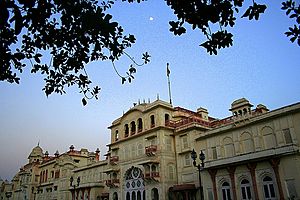
Tourism in Indian Punjab focuses on its historic palaces, battle sites, and beautiful Sikh architecture. You can visit sites from the ancient Indus Valley civilization. There is also the old fort of Bathinda. The cities of Kapurthala, Patiala, and Chandigarh have impressive buildings. Chandigarh was designed by the famous architect Le Corbusier.
The Golden Temple in Amritsar is a major tourist spot in Punjab and India. It attracts more visitors than the Taj Mahal. Lonely Planet called the Harmandir Sahib one of the world's best spiritual sites. Many international hotels are available in Amritsar for visitors.
Devi Talab Mandir is a Hindu temple in Jalandhar. It is dedicated to Goddess Durga and is believed to be at least 200 years old. Another important place to visit is Sri Anandpur Sahib. Many tourists come to see the Virasat-e-Khalsa (Khalsa Heritage Memorial Complex). They also take part in the Hola Mohalla festival.
The Kila Raipur Sports Festival is also a popular tourist event. Other attractions include Shahpur Kandi Fort, Ranjit Sagar lake, and a Sikh Temple in Sri Muktsar Sahib. Punjab also has the world's first museum about the 1947 Partition of India. It is called the Partition Museum and is in Amritsar.
Images for kids
-
Rig Veda is the oldest Hindu text that originated in the Punjab region.
-
Wagah Border is situated between Amritsar and Lahore, became the main border crossing after partition of Punjab and is known for its elaborate ceremony
-
Hall Gate of Amritsar
-
The Ranjit Singh Block at Guru Nanak Dev University
-
Guru Gobind Singh Bhawan at Punjabi University
See also
 In Spanish: Punyab (India) para niños
In Spanish: Punyab (India) para niños








